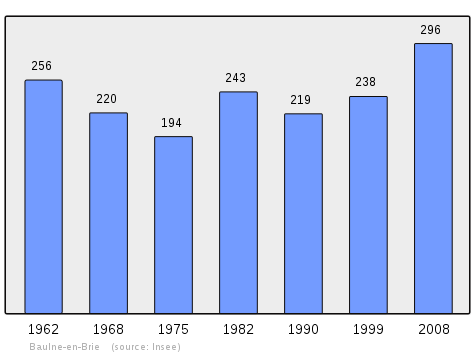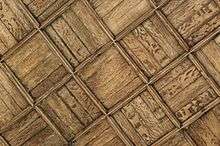Baulne-en-Brie
Baulne-en-Brie is a former commune in the department of Aisne in northern France. On 1 January 2016, it was merged into the new commune Vallées-en-Champagne.[2]
Baulne-en-Brie | |
|---|---|
Part of Vallées-en-Champagne | |
 | |
Location of Baulne-en-Brie 
| |
 Baulne-en-Brie  Baulne-en-Brie | |
| Coordinates: 48°59′16″N 3°36′53″E | |
| Country | France |
| Region | Hauts-de-France |
| Department | Aisne |
| Arrondissement | Château-Thierry |
| Canton | Condé-en-Brie |
| Commune | Vallées-en-Champagne |
| Area 1 | 18.89 km2 (7.29 sq mi) |
| Population (2017)[1] | 264 |
| • Density | 14/km2 (36/sq mi) |
| Time zone | UTC+01:00 (CET) |
| • Summer (DST) | UTC+02:00 (CEST) |
| Postal code | 02330 |
| Elevation | 82–243 m (269–797 ft) (avg. 100 m or 330 ft) |
| 1 French Land Register data, which excludes lakes, ponds, glaciers > 1 km2 (0.386 sq mi or 247 acres) and river estuaries. | |
Geography
Baulne-en-Brie is located some 15 km east by south-east of Château-Thierry and 20 km west by south-west of Épernay. It can be accessed by the D4 road from Condé-en-Brie in the west through the heart of the commune and the village and continuing east to Le Breuil. There is also a country road from La Chapelle-Monthodon in the north. The south-eastern border of the commune is part of the border between the departments of Aisne and Marne. There are three hamlets in the commune other than the village: Montchevret, Grande Fontaine, and Romandie. There are extensive forests in the north, centre, south-east and south of the commune with the rest of the area being farmland.[3]
The Verdonnelle stream flows north-west through the southern part of the commune passing near the hamlet of Romandie and continuing north-west out of the commune. The Surmelin stream flows from the south-east passing through the village and continuing north-west to join the Marne near Mézy-Moulins.[3]
Neighbouring communes and villages[3]
Administration
List of Successive Mayors of Baulne-en-Brie[4]
| From | To | Name | Party | Position |
|---|---|---|---|---|
| 2001 | 2008 | Gilles Hiernard | DVD | |
| 2008 | 2020 | Bruno Lahouati |
(Not all data is known)
Demography
In 2010 the commune had 288 inhabitants. The evolution of the number of inhabitants is known through the population censuses conducted in the commune since 1793. From the 21st century, a census of municipalities with fewer than 10,000 inhabitants is held every five years, unlike larger towns that have a sample survey every year.[Note 1]
| 1793 | 1800 | 1806 | 1821 | 1831 | 1836 | 1841 | 1846 | 1851 |
|---|---|---|---|---|---|---|---|---|
| 428 | 515 | 572 | 589 | 637 | 628 | 673 | 730 | 724 |
| 1856 | 1861 | 1866 | 1872 | 1876 | 1881 | 1886 | 1891 | 1896 |
|---|---|---|---|---|---|---|---|---|
| 702 | 639 | 633 | 562 | 537 | 504 | 512 | 527 | 510 |
| 1901 | 1906 | 1911 | 1921 | 1926 | 1931 | 1936 | 1946 | 1954 |
|---|---|---|---|---|---|---|---|---|
| 442 | 420 | 440 | 380 | 371 | 334 | 347 | 299 | 268 |
| 1962 | 1968 | 1975 | 1982 | 1990 | 1999 | 2006 | 2007 | 2010 |
|---|---|---|---|---|---|---|---|---|
| 256 | 220 | 194 | 243 | 219 | 238 | 284 | 290 | 288 |

Economy
Baulne-en-Brie is an agricultural and wine-producing village and a part of the Appellation d'origine contrôlée (AOC) zone for "Champagne of Aisne".
Culture and heritage
Civil heritage
The commune has two sites that are registered as historical monuments:
- Other sites of interest
- The Place Daniel Beaucreux in front of the church. In memory of the men and women of the Canton of Condé-en-Brie and the region who experienced deportation and death in the Nazi concentration camps. Marked: "Dead in Deportation, alive in our memories".
- A Lavoir (Public laundry) in the main street has been decorated on the theme of the fable "The dairy and milk jug".
- Little Switzerland of Condé, the area around the hamlet of Romandie, gives access to the Verdonnelle valley.
- A Directional table opposite the Chemin de Glapiers on the road to Saint-Agnan offers an outstanding view of the Surmelin valley.
Religious heritage


The commune has several religious buildings and structures that are registered as historical monuments:
- The Church of Saint Bartholomew (12th century).

See also
Notes
- At the beginning of the 21st century, the methods of identification have been modified by law No. 2002-276 of 27 February 2002 , the so-called "law of local democracy" and in particular Title V "census operations" which allow, after a transitional period running from 2004 to 2008, the annual publication of the legal population of the different French administrative districts. For municipalities with a population greater than 10,000 inhabitants, a sample survey is conducted annually, the entire territory of these municipalities is taken into account at the end of the period of five years. The first "legal population" after 1999 under this new law came into force on 1 January 2009 and was based on the census of 2006.
References
- Téléchargement du fichier d'ensemble des populations légales en 2017, INSEE
- Arrêté préfectoral 23 November 2015 (in French)
- Google Maps
- List of Mayors of France (in French)
- Ministry of Culture, Mérimée IA02001301 Madame Max Park (in French)
- Ministry of Culture, Mérimée IA02001300 Chateau Park (in French)
- Ministry of Culture, Mérimée PA00115519 Church of Saint Bartholomew (in French)

- Ministry of Culture, Palissy PM02000071 Funeral Plaque of Madeleine de Castellan, widow of Louis Mallart, Counsellor to the King (in French)
- Ministry of Culture, Palissy PM02000070 Tombstone of Guillaume de Baulne (in French)

- Ministry of Culture, Palissy PM02000069 Pulpit with 3 Bas-reliefs (in French)

External links
- Baulne-en-Brie on the old National Geographic Institute website (in French)
- Baulne-en-Brie on the Union for initiative of the canton of Condé-en-Brie official website (in French)
- Baulne-en-Brie official website (in French)
- The Prison Door from La Petite Roquette prison (in French)
- Baulne-en-Brie on Lion1906
| Wikimedia Commons has media related to Baulne-en-Brie. |